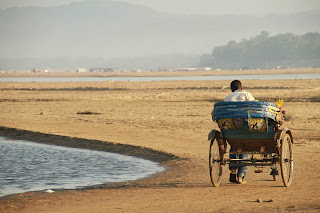I learnt about the World Social Forum years ago, an open meeting place where social movements, networks, individuals, NGOs and other civil society organisations come together to oppose war, commercial globalisation, militarisation, capitalism and neo-liberal imperialism, and to pursue their thinking about 'another world' of equality, social justice, and sustainability. Its formation was inspired by the mass upsurge across Latin America, in particular the struggle of the Zapitistas in southern Mexico and the 1999 Seattle protests against the World Trade Organisation.
I had been to the Melbourne Social Forum, the micro-scale version of the above, a little collection of friendly stalls at CERES Environment Park in Brunswick. All very interesting, but unfortunately it seemed to only attract people already quite involved in the usual campaigns...
So when I heard that the
South Asian Social Forum would be coming to Dhaka, I was very curious. Scheduled for November 18-22th, it took place at Dhaka University, which has a long history as a platform for nurturing democratic and progressive movements. The university was the centre of Bangladesh’s historic language movement in 1952, which demanded recognition of Bangla as a national language. Its students and teachers played a key role in the national upsurge in 1969, and the liberation war in 1971.
The main theme for the South Asia Social Forum Bangladesh was "Democracy for Social Transformation in South Asia: Participation, Equity, Justice and Peace", with various subthemes clustered as following:
Democracy and People’s Participation: Democracy, decentralization, corruption, demilitarization.
Human Rights and Dignity : Fundamental rights, child rights, women rights, labor rights, rights of indigenous people.
Privatization vs Public Services : Education, people’s health (Public Heath Care, HIV/AIDS.), water rights, knowledge technology and people’s entitlement.
Food Sovereignty & Livelihood Security : Farmers’ rights, corporate agriculture, food rights, hunger. land rights, natural resource: (forest, water & mineral resources).
Development Finance : People’s globalization vs IFIs, aid accountability, corporate accountability, trade justice.
Regional and Trans-boundary Concerns : Climate justice, regional cooperation, peace and security (religious fundamentalism, cast, class and ethnicity), migration and trafficking, water sharing.
The basic goal of SASF was to contribute towards creating a new South Asia, free from poverty and hunger caused by deprivation, exploitation, discrimination, and establish a common humanity based on equality, freedom and justice.
So it was with high hopes that I arrived at Dhaka University right on time at 10am on Sat 19th for the morning session on 'Green Governance in coastal communities'. It was then that I realised that - like in Australia - passionate people don't necessarily make for organised people. There were volunteer guides in immaculate uniforms but no one had a map or a program or seemed to know what was going on. Eventually I found the room, rushing in 40 min late to find... no one there. Luckily one of the guides was able to take me to an auditorium where one of the main plenaries was being held, with the title 'Another South Asia is Possible'. Unfortunately the speaker's microphone seemed to be set on the 'muffle' setting and he sounded like he was speaking from underwater. Fortunately this was corrected for the next few speakers, who were interesting and inspiring. The last was a passionate woman in her 60s who spoke about many things, one of which was how she viewed herself as a South Asian citizen before she saw herself as Bangladeshi, a shift which invites a broader view outside of nationalistic agendas. It made me think about how I saw/should see myself - as an Australian, an Asia-Pacifican (!), or simply as a world-citizen.
After this I joined the market place of stalls - hundreds ranging from international NGOs to grassroots groups to movement organisations. An NGO called the
Bangladesh Resource Center for Indigenous Knowledge (BARCIK) displayed over a hundred different indigenous rice varieties, many of which are rare after the Green Revolution in the 1960s and 70s promoted high yielding varieties (HYV) with chemical inputs (pesticides, fertilisers). A growing number of farmers are now seeking alternatives to HYV because of their cost and negative impacts to the soil. There were talks going on and hundreds of people wandered about in carnival like atmosphere. At another seminar, 'Climate Change and Urbanisation, Perspective Bangladesh', when myself and my colleague Kanika wandered in late, we were promptly asked to introduce ourselves up front with the microphone, which we did. Often 'bideshis' (foreigners) are thought of as instant experts - luckily I did not speak long enough for them to realise that this was not the case.
In the evening there were some films screening via projector. One was an arty doco on consumerism. It was an odd feeling to be watching the perils of the consumerist lifestyle in rich countries whilst standing in one of the poorest countries on earth, with the deja vu feeling of recognising your own country in the images, yet being apart from it for so long (well seven months anyway). I had this feeling at various times during the forum, when people spoke against the developed world and their strings-attached, NGO interventions into the developing countries. Still, it didn't end up detracting from the feeling of solidarity and hope that was around the forum, and if anything invites the question of your own subject position and role in the ongoing re-creation that is Bangladesh...
Thanks to
GLW for some of the background information to this post.




